On the second matchday of the UEFA Champions League 2023/24 Group of Death, Newcastle United and Paris Saint-Germain met.
Newcastle United can carry on the momentum from last season and are still on the rise thanks to the financial injection from Saudi Arabia. Most recently, the newly rich club even knocked Champions League winners Manchester City out of the English League Cup (1-0).
Meanwhile, the French didn’t exactly travel to the island in top form. The goalless draw at Clermont Foot at the weekend was the fourth game without a win in seven league games. However, on the first matchday of the UEFA Champions League, the French capital team confidently defeated Borussia Dortmund 2-0.
In this tactical analysis, we delve into a comprehensive match analysis of the thrilling UEFA Champions League encounter between Newcastle United and Paris Saint-Germain, dissecting the tactics and strategies that unfolded during this high-stakes clash.
Lineups
In the highly anticipated clash, the starting lineups for both Newcastle United and Paris Saint-Germain showcased their tactical intentions.
Adopting a 4-3-3 formation, Newcastle placed their trust in Nick Pope guarding the goal, while their defensive quartet featured Kieran Trippier, Jamaal Lascelles, Fabian Schär, and Dan Burn. The midfield trio of Bruno Guimaraes, Sean Longstaff, and Sandro Tonali aimed to dictate the tempo. In contrast, the attacking trio of Miguel Almiron, Alexander Isak, and Anthon Gordon sought to unlock PSG’s defence.
On the other side, PSG deployed a dynamic 4-2-3-1 formation, with the presence of Gianluigi Donnarumma in goal. Their defensive line consisted of Achraf Hakimi, Marquinhos, Milan Skriniar, and Lucas Hernandez. In midfield, Manuel Ugarte and Warren Zaïre-Emery aimed to provide control. In contrast, the attacking midfield trio of Ousmane Dembele, Kylian Mbappe, and Randal Kolo Muani should pose a constant threat. Adding to the firepower, Goncalo Ramos took up a vital role in the offensive setup.
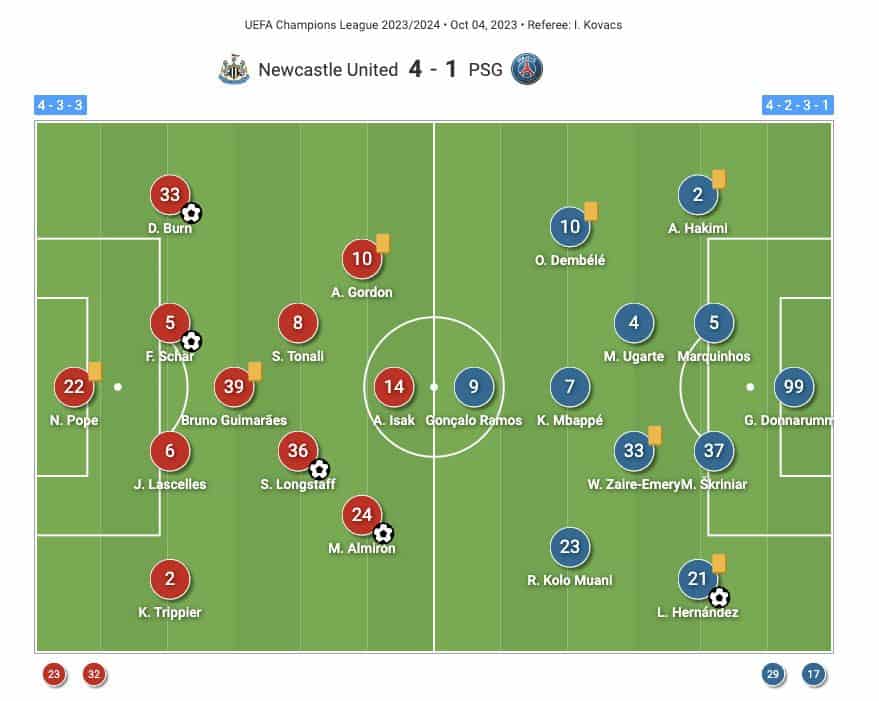
PSG’s tactics were more intriguing because they aimed to be flexible by using four forwards. In possession, they seamlessly transitioned into a potent 4-2-4 formation, applying pressure and pushing forward. However, they reverted to a 4-4-2 shape without possession, potentially exposing themselves to counterattacks. This tactical evolution promised an enthralling battle on the pitch.
Newcastle’s man-orientation
Against low-lying clubs, PSG find it challenging to find their way into the game. But as we will see in this analysis, this playing style doesn’t suit Newcastle. Therefore, they approached the game very differently than, for example, Borussia Dortmund in the first group game against PSG. The question looming over everyone’s minds was whether Eddie Howe would stick to his playing philosophy of aggression and press against PSG. Early in the game, it became evident that individual pressing was at play.
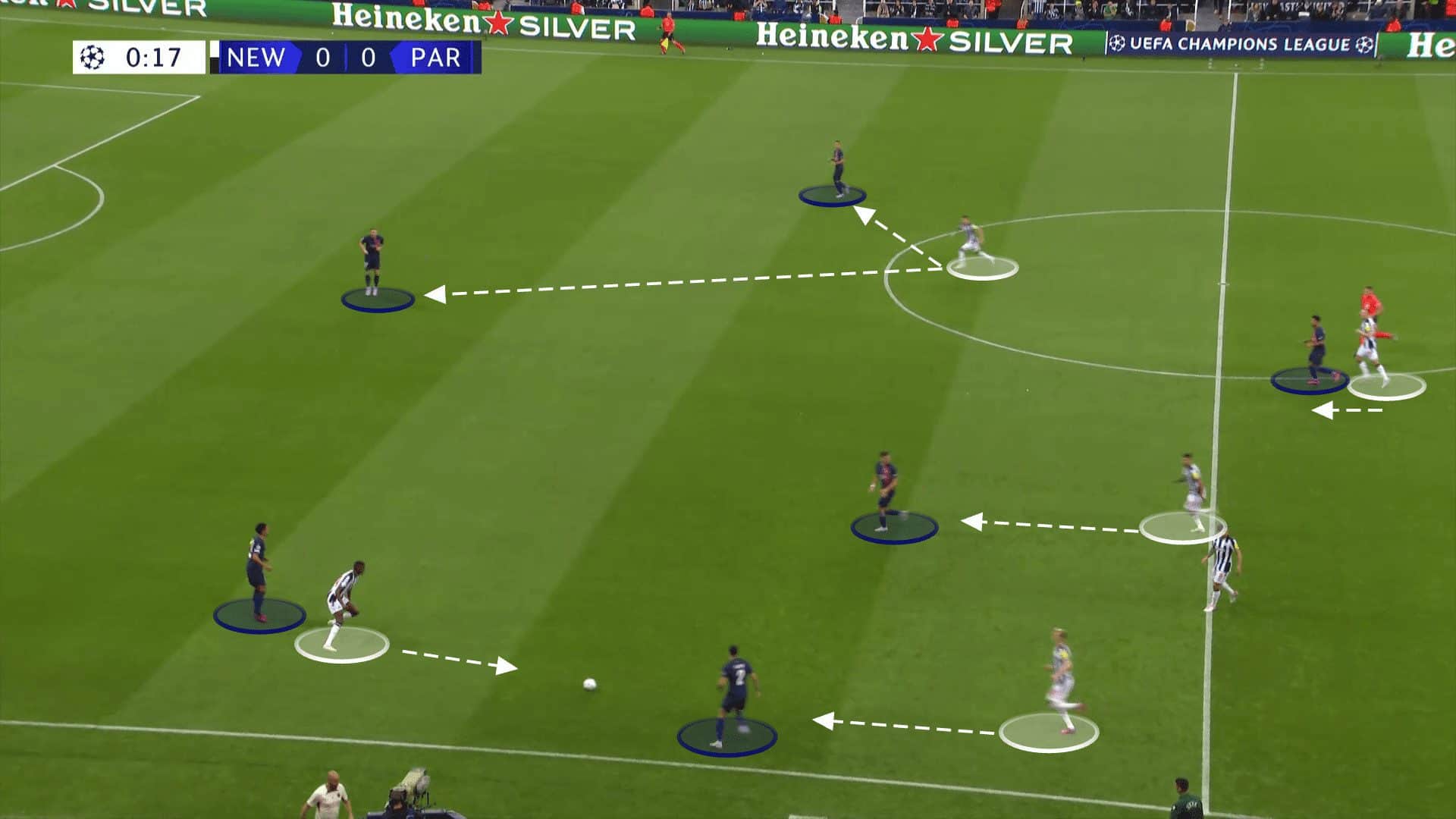
Newcastle’s pressing strategy was triggered when the ball carrier opted for a wide pass to the full-back. In such instances, they seamlessly transitioned into a 4-5-1 formation, closing down vertical passing lanes. The midfield trio for Newcastle shifted across to tighten spaces on the side where the ball was located.
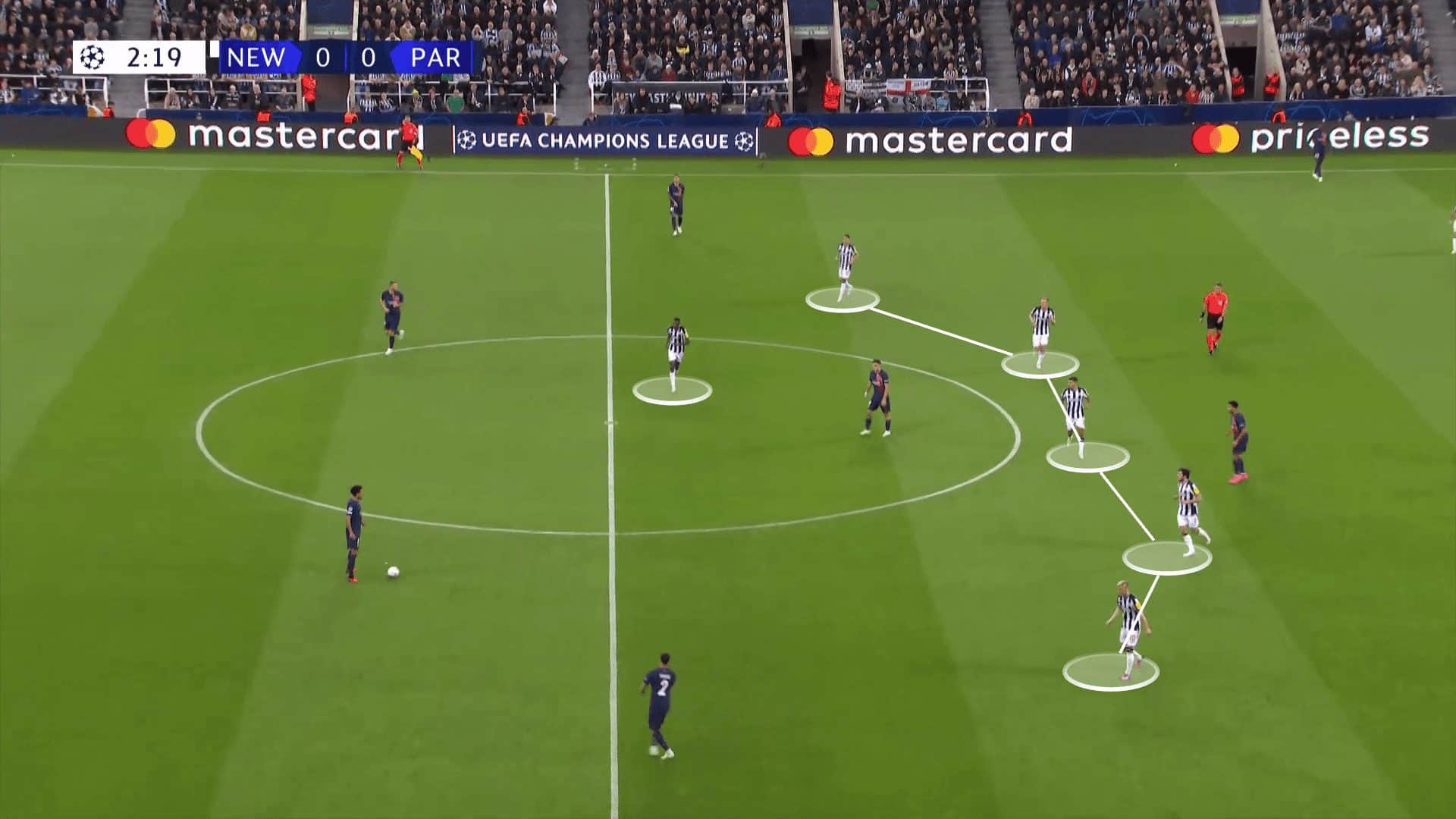
The initiation of the pressing structures largely rested on Bruno Guimaraes and Gordon. When the left winger pressed Hakimi, forcing him into a back pass, Isak and Almiron would then hound the defenders. The wingers played a pivotal role by making aggressive runs. Gordon and Almiron were instrumental in this regard, with their runs serving as triggers for the press and setting the tempo.
PSG’s strategy revolved around building up play on the flanks, with an eye on exploiting potential spaces behind the opposition. This made Howe’s man-oriented press crucial, with Tonali providing support to Gordon during the press, ensuring numerical parity.
The success of Newcastle’s pressing hinged on pairs working in tandem. Bruno and Longstaff, Almiron and Isak, and Tonali and Gordon covered substantial ground on the pitch. Each duo had specific players to mark, creating numerical superiority for the Magpies and stifling PSG’s progress.
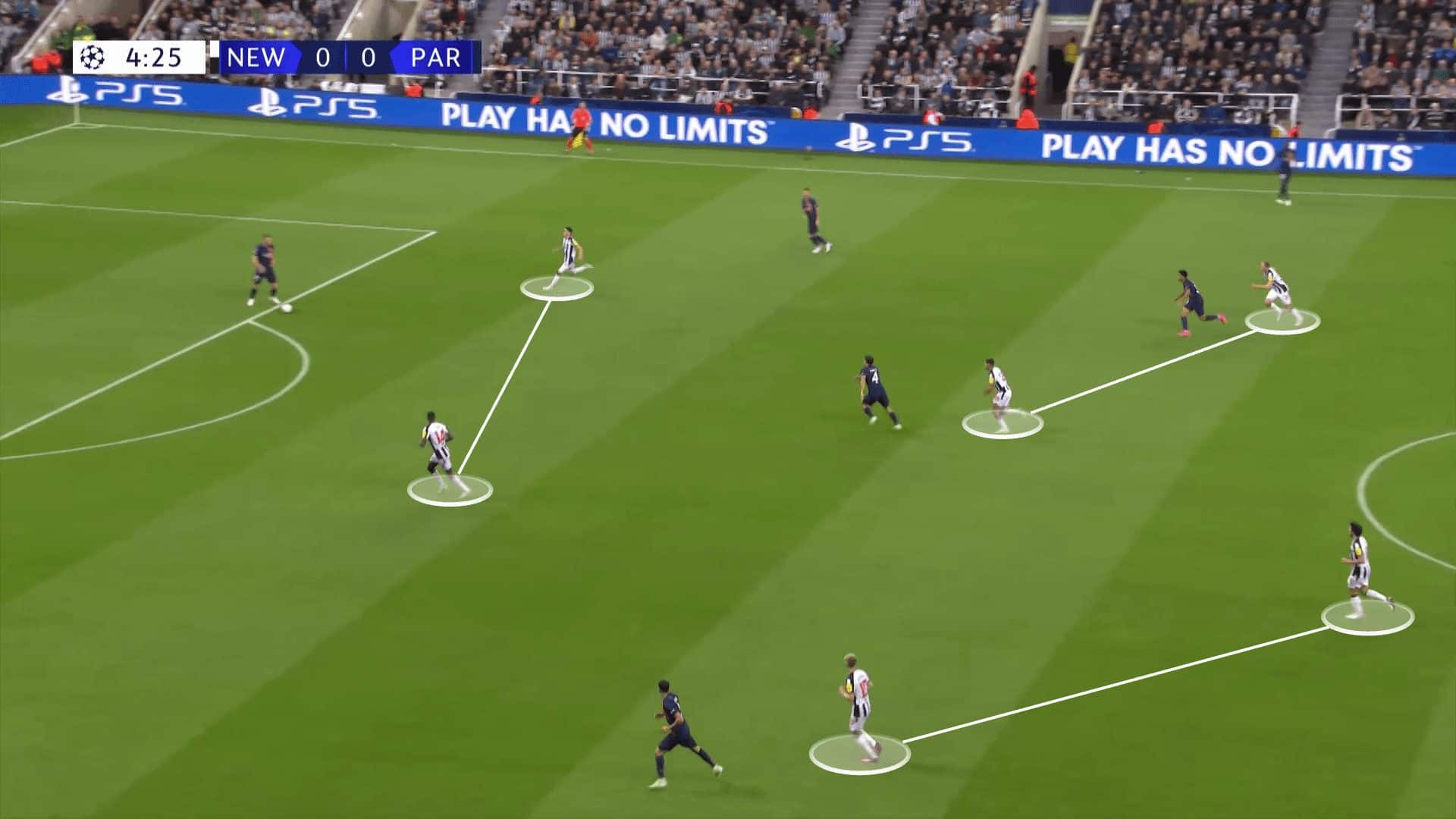
While it took time to implement, this match proved that Newcastle’s pressing structure can be successful. This is something to take with them in their Premier League season, where their pressing is rather average, with 11.56 PPDA and a challenge intensity of 5.44.
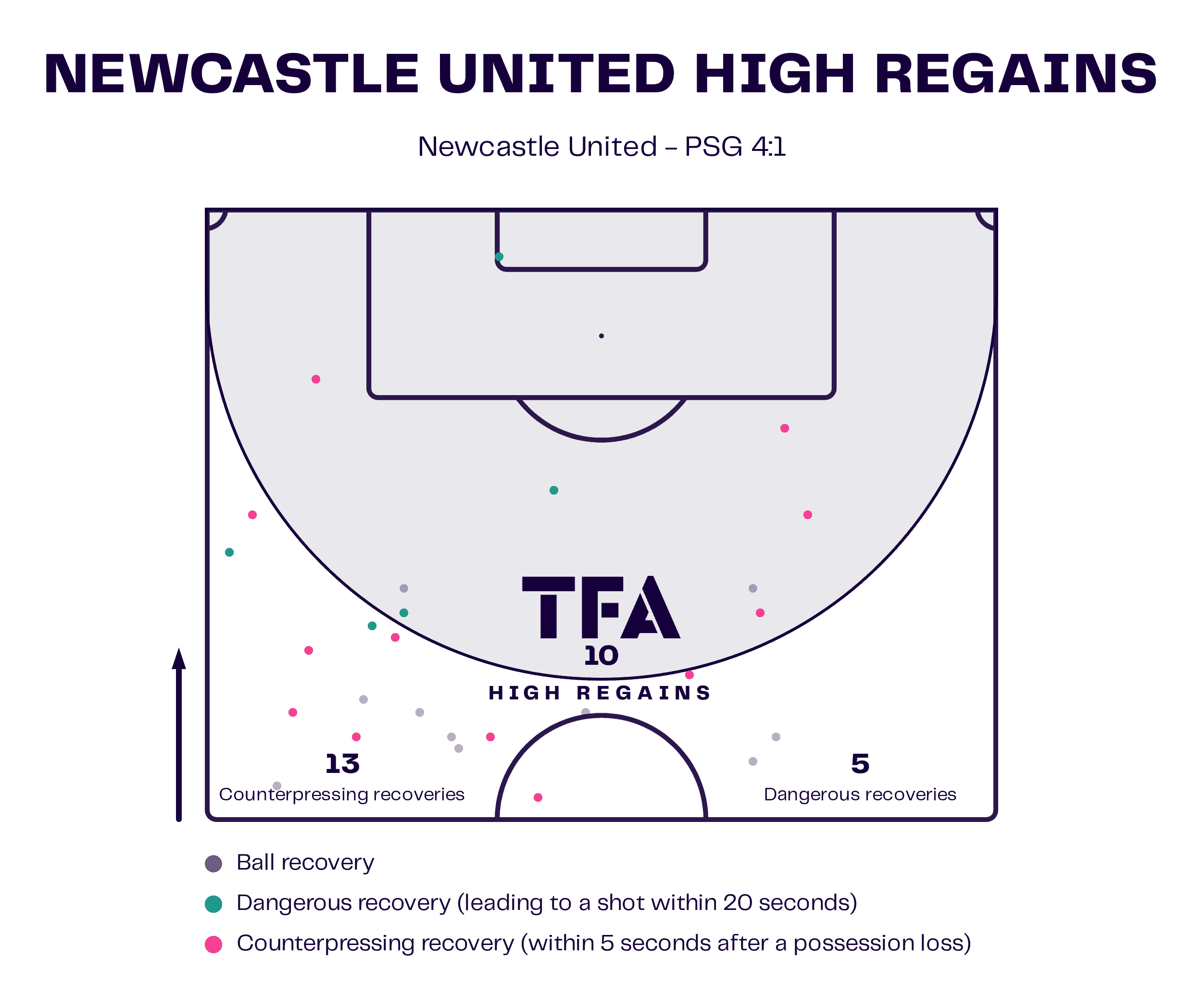
Ugarte, as a key player
Ugarte emerged as the pivotal figure under Newcastle’s watchful eye for man-marking duties. Witnessing a 2v1 situation with Tonali pushing high to apply pressure on Hakimi was common. The Magpies adeptly alternated between an aggressive pressing approach and a structured 4-5-1 formation when the ball resided centrally. Their strategy involved selectively pressing Ugarte when he assumed control of the ball.
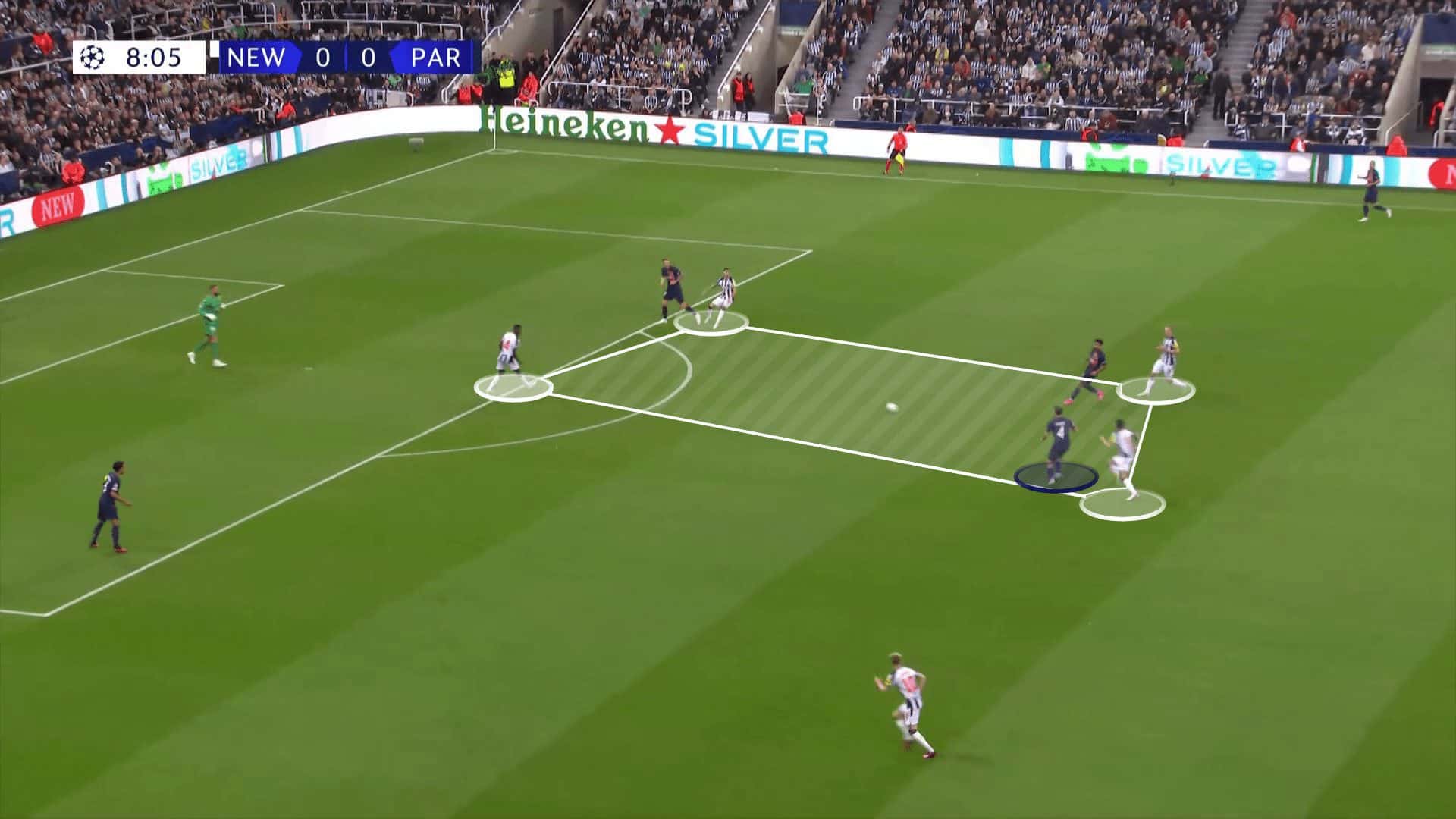
This tactical choice showcased their intelligence by thwarting attempts at threading passes between the lines, compelling PSG to opt for wider passes, which, in turn, enabled Newcastle to commence their pressing game.
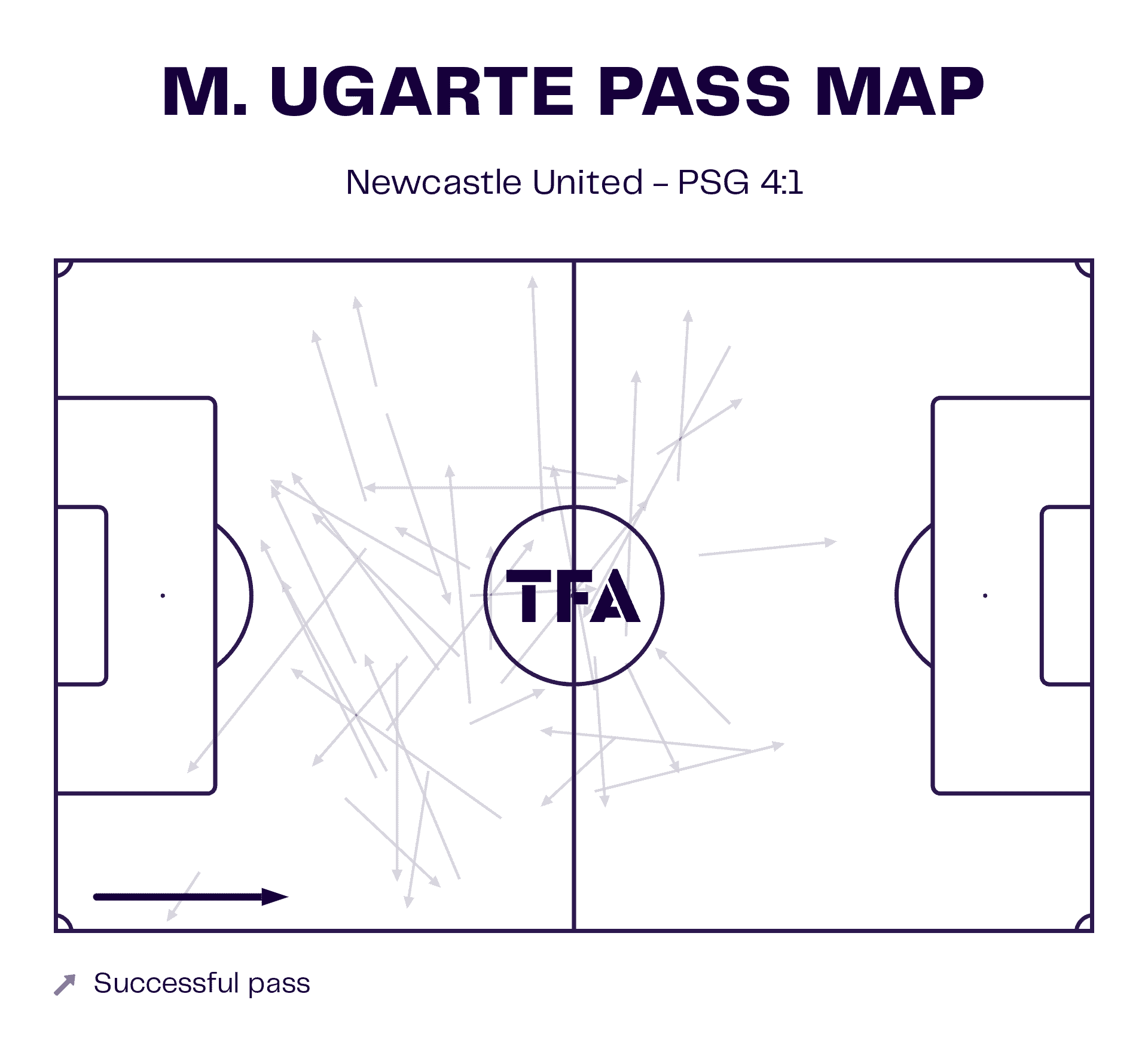
It became clear that Newcastle’s players wholeheartedly fit into this pressing style. The involvement of the centre-backs deserves special mention as a testament to the team’s commitment to this strategy.
PSG’s solution approaches
PSG found themselves in a numerical disadvantage in midfield, so their primary choice for build-up was to distribute the ball out wide or make direct passes to the forward players. Consequently, their reliance on long passes surged significantly during this match, accounting for 7.15% of their total passes, a notable increase compared to their season average of 3.96%.
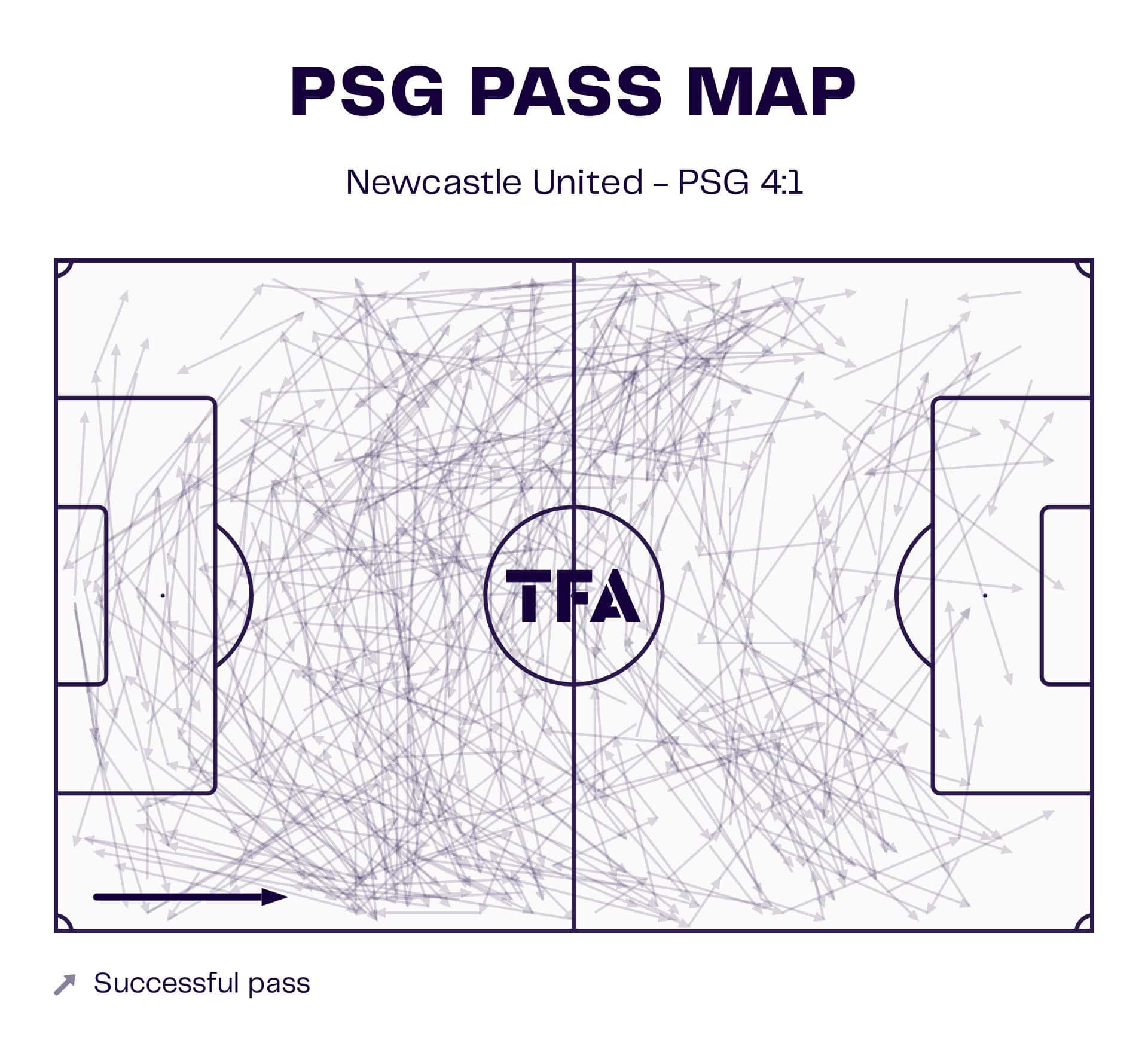
Enrique’s tactical approach was centred on luring Newcastle’s press forward to exploit the spaces left behind. But, the timing of the passes executed by Marquinhos and Skriniar was often off the mark, resulting in delayed decision-making. This lapse in timing played directly into Newcastle’s hands, and they capitalized on this by winning back possession in hazardous areas.
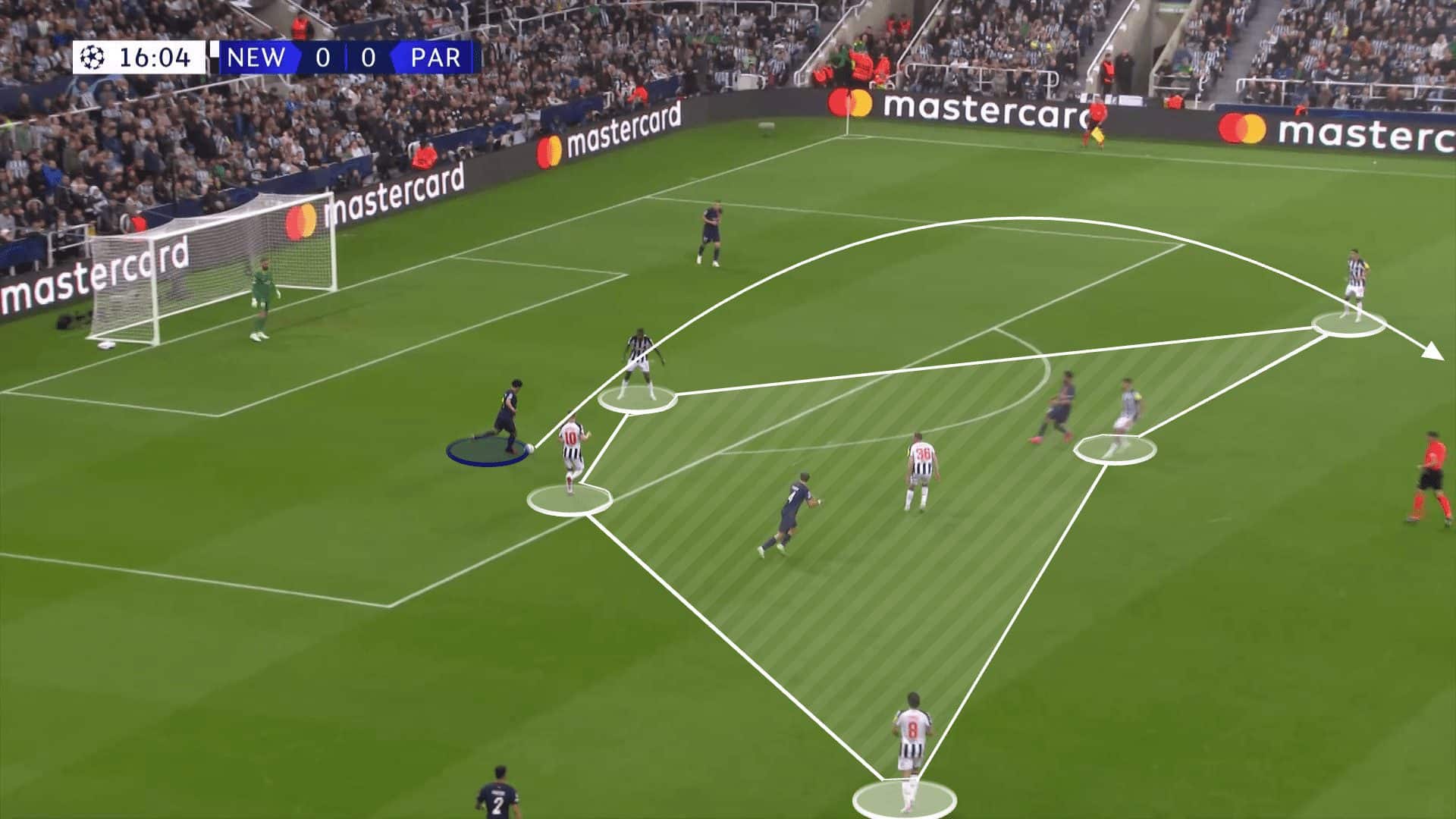
The limitations of PSG’s defenders were evident due to Newcastle’s numerical advantage of in central midfield. When they did manage to execute their passes effectively to the forward players, the latter failed to make significant progress in advancing the play.
Enrique opted for a double-pivot strategy in an effort to draw out Newcastle’s press to the fullest extent possible. However, Guimaraes and Longstaff’s impeccable man-marking of Zaire-Emery and Ugarte disrupted this plan.
This allowed Gordon to join forces with Isak while Tonali effectively pressed Hakimi on the right flank. The consequence of this coordinated defensive effort by Newcastle was an elevated number of ball losses, amounting to 100 during the match—exceeding their season average of 90. Additionally, PSG’s average pass count per player, which stood at 5.45, fell significantly below their season average of 8.32.
PSG in possession
As Newcastle took a comfortable lead, they adopted a mid-block defensive posture, and as a consequence, the intensity of their high press understandably diminished. Their midfield was strategically positioned to thwart any attempts at threading passes through the centre of the pitch and breaking the lines.
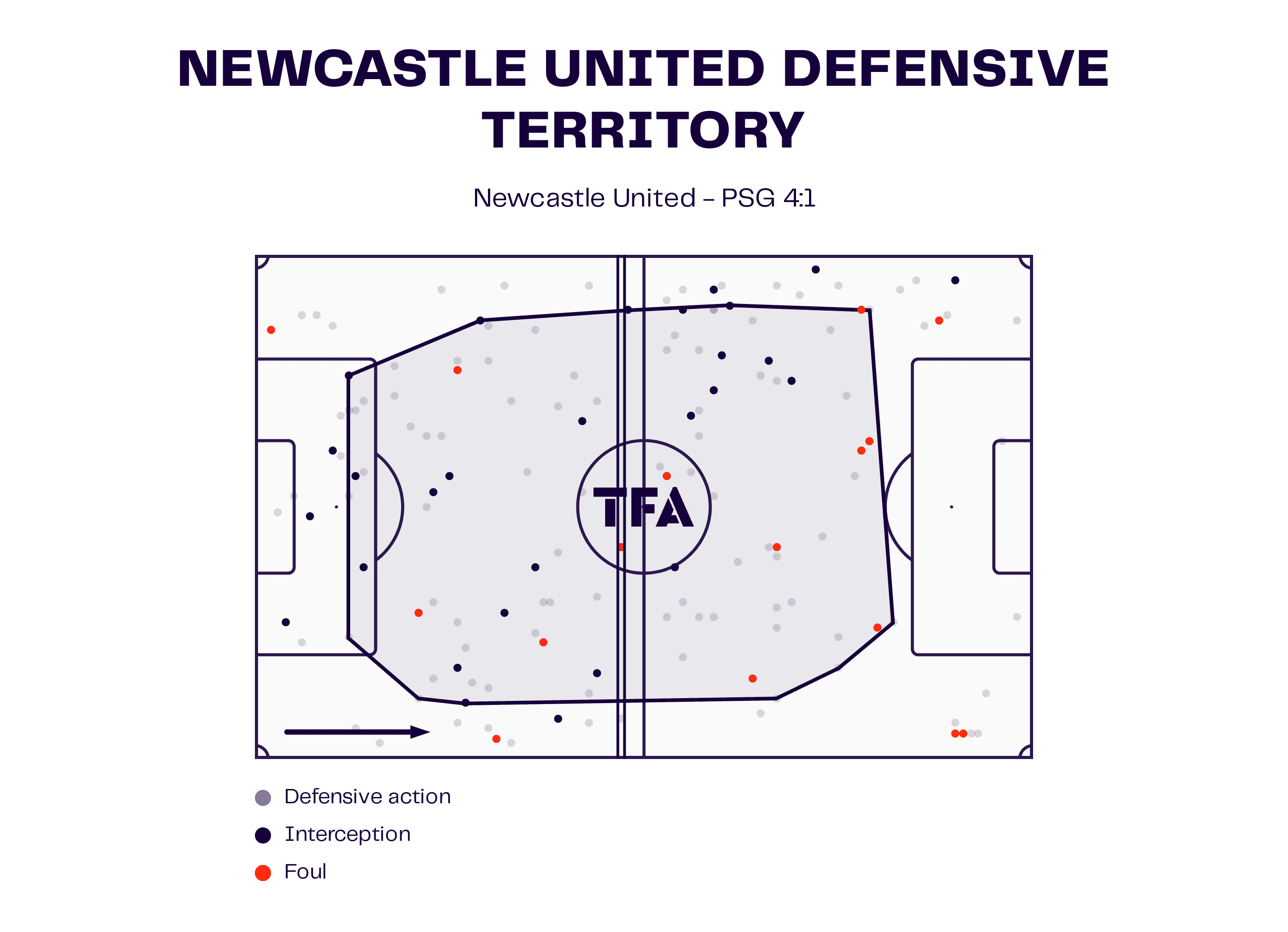
Due to the dearth of passing options in central midfield to assert control, PSG found themselves unable to execute switches of play and endeavoured to create attacking opportunities despite being at a numerical disadvantage.
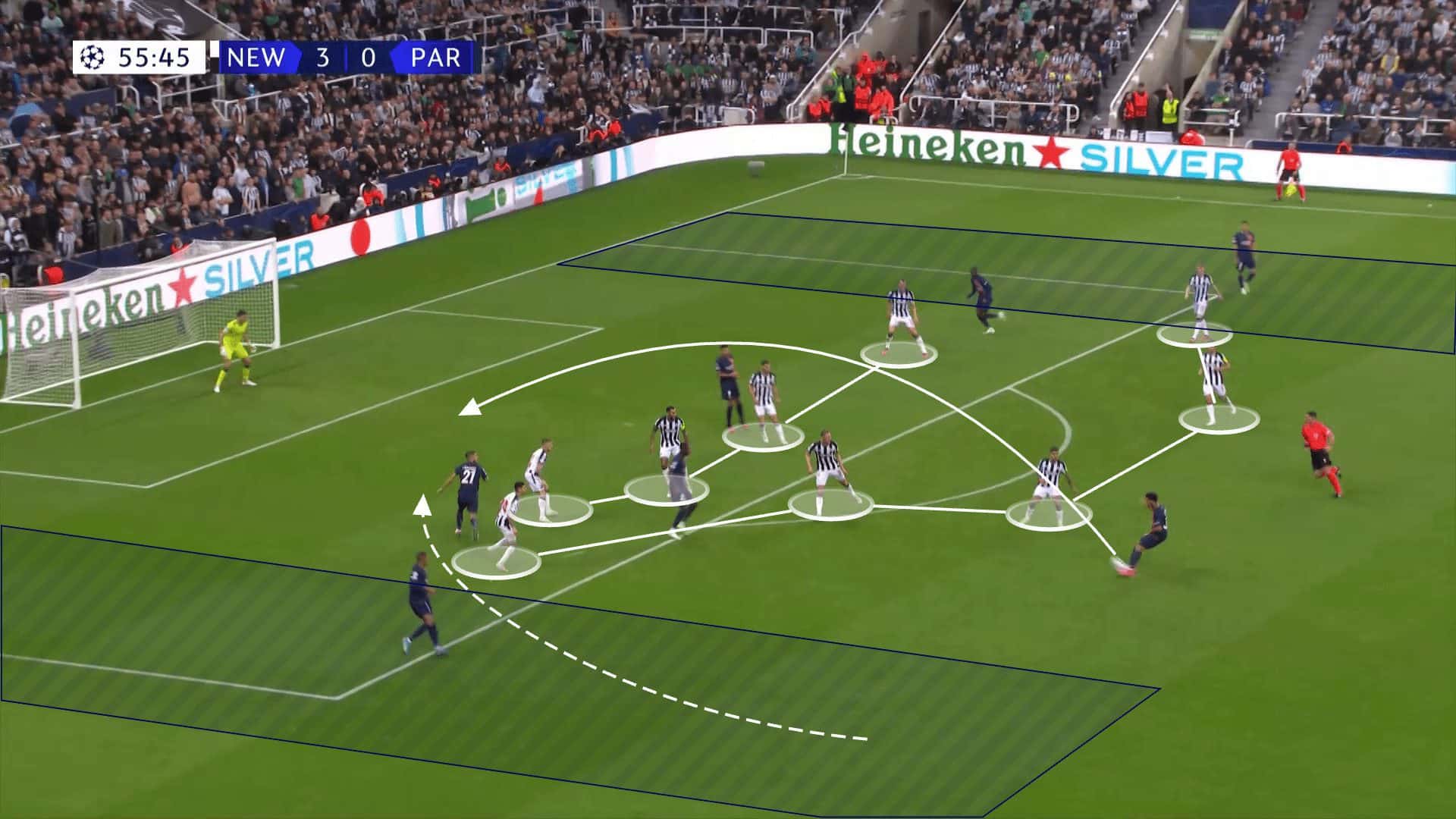
PSG managed to apply pressure primarily in the vicinity of Newcastle’s penalty area, especially in wide positions. Given Newcastle’s deep defensive setup, PSG effectively circulated the ball. While Newcastle exhibited swift lateral movement with one exemption: the only goal from PSG.
Conclusion
Eddie Howe‘s side demonstrated tactical discipline, transitioning between an aggressive press and a more structured defensive shape when required. PSG found it challenging to create meaningful chances, and Newcastle’s ability to adapt and maintain their tactical structure played a crucial role in securing their well-deserved victory.





Comments